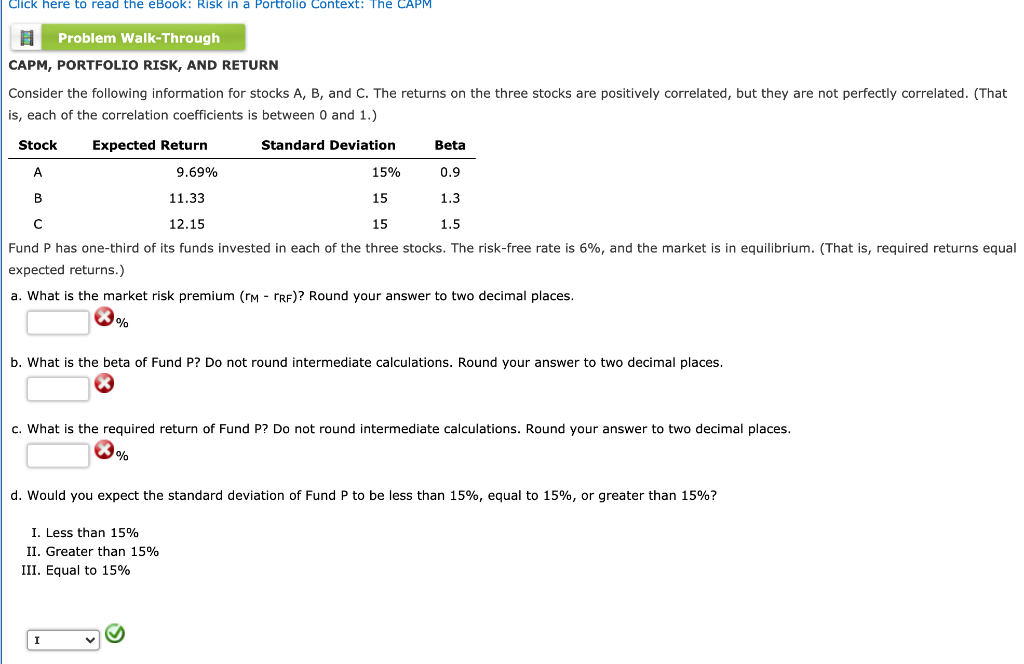

Click here to read the eBook: Risk in a Portfolio Context: The CAPM B Problem Walk-Through CAPM, PORTFOLIO RISK, AND RETURN Consider the following information for stocks A, B, and C. The returns on the three stocks are positively correlated, but they are not perfectly correlated. (That is, each of the correlation coefficients is between 0 and 1.) Stock Expected Return Standard Deviation Beta A 9.69% 15% 0.9 B 11.33 15 1.3 12.15 15 1.5 Fund P has one-third of its funds invested in each of the three stocks. The risk-free rate is 6%, and the market is in equilibrium. (That is, required returns equal expected returns.) a. What is the market risk premium (TM - PRF)? Round your answer to two decimal places. % b. What is the beta of Fund P? Do not round intermediate calculations. Round your answer to two decimal places. c. What is the required return of Fund P? Do not round intermediate calculations. Round your answer to two decimal places. % d. Would you expect the standard deviation of Fund P to be less than 15%, equal to 15%, or greater than 15%? I. Less than 15% II. Greater than 15% III. Equal to 15% I Problem Walk-Through EVALUATING RISK AND RETURN Stock X has a 10.0% expected return, a beta coefficient of 0.9, and a 40% standard deviation of expected returns. Stock Y has a 13.0% expected return, a beta coefficient of 1.3, and a 30.0% standard deviation. The risk-free rate is 6%, and the market risk premium is 5%. a. Calculate each stock's coefficient of variation. Round your answers to two decimal places. Do not round intermediate calculations. CVX = CVy = b. Which stock is riskier for a diversified investor? 1. For diversified investors the relevant risk is measured by beta. Therefore, the stock with the higher beta is less risky. Stock Y has the higher beta so it is less risky than Stock X. II. For diversified investors the relevant risk is measured by beta. Therefore, the stock with the higher beta is more risky. Stock Y has the higher beta so it is more risky than Stock X. III. For diversified investors the relevant risk is measured by standard deviation of expected returns. Therefore, the stock with the higher standard deviation of expected returns is more risky. Stock X has the higher standard deviation so it is more risky than Stock Y. IV. For diversified investors the relevant risk is measured by beta. Therefore, the stock with the lower beta is more risky. Stock X has the lower beta so it is more risky than Stock Y. V. For diversified investors the relevant risk is measured by standard deviation of expected returns. Therefore, the stock with the lower standard deviation of expected returns is more risky. Stock Y has the lower standard deviation so it is more risky than Stock X. | c. Calculate each stock's required rate of return. Round your answers to two decimal places. % mo ry = d. On the basis of the two stocks' expected and required returns, which stock would be more attractive to a diversified investor? Stock Yv e. Calculate the required return of a portfolio that has $6,500 invested in Stock X and $3,000 invested in Stock Y. Do not round intermediate calculations. Round your answer to two decimal places. fp = % f. If the market risk premium increased to 6%, which of the two stocks would have the larger increase in its required return? Stock Y








